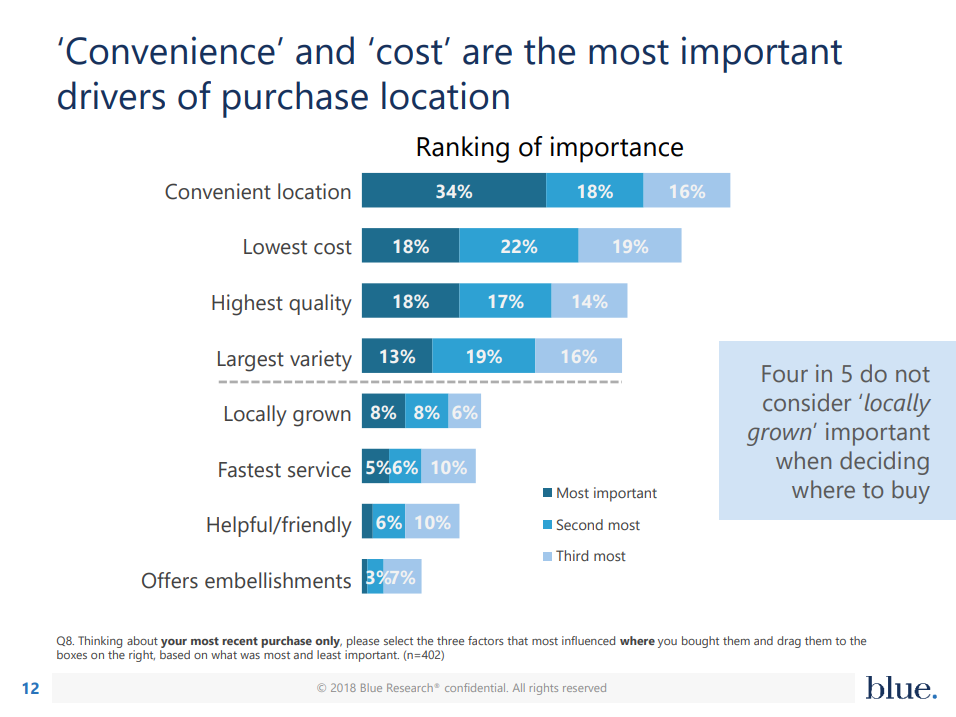Slow Flowers Society sponsors Cut Flower Questions on the 2021 National Gardening Survey

We are so excited to announce two new benchmarks on U.S. consumer attitudes toward buying American-grown and locally-grown cut flowers! Sponsored in part by the Slow Flowers Society, the 2021 National Gardening Survey asked two new and important questions:
1. When purchasing cut flowers, how important is it that the flowers are American-grown?
2. When purchasing cut flowers, how important is it that the flowers are locally-grown?
According to the National Gardening Association’s research director Paul Cohen, who conducted the omnibus 2021 survey of nearly 2,500 U.S. households, past surveys asked one question about cut flowers, flower arrangements and silk flowers.
“However, that question in the past was only asked of those who identified themselves as garden-participating households,” he says. “You shared your desire to gather more of a national opinion of everyone, because you certainly do not have to be a gardener to buy cut flowers — in fact, many non-gardeners do buy flowers. And so we incorporated a new series of questions and asked all respondents as a national representative sample.”

Here is how the Survey Reads:
Q7215 How much money, in total, did you spend in 2020 on cut flowers (for yourself or as gift for someone else)? If you’re not sure, please make your best estimate. If you did not purchase cut flowers, please enter “0.” Please enter your responses in whole dollars only.
Dollars spent [RANGE = 0-20000]
01 Cut flowers |_|_|_|_|_|
Q7220 When buying cut flowers, how important is it to you that the cut flowers be…
Q7221 Grown in the United States?
Q7222 Grown locally?
- Very important
- Somewhat important
- Not very important
- Not at all important
CONSUMER BEHAVIOR:
Four in ten U.S. adults (41%, 104.6 million) report spending some amount of money on cut flowers in 2020, with an average household expenditure of $62.63, or an estimated $6.55 billion spent by U.S. households last year.
CONSUMER ATTITUDES:
The findings are encouraging and it’s awesome to have sponsored the newest baseline insights about What is Important to Consumers When Buying Cut Flowers!
57 percent of survey respondents say when buying cut flowers that it is very or somewhat important to them that the flowers are grown in the U.S. and 58 percent say it is very or somewhat important that the flowers they purchase are locally-grown.
BACKGROUND: Since the founding of Slow Flowers Society in 2013, I’m only aware of two other surveys that have ever asked consumers about their attitudes toward domestic and local cut flowers. I strongly believe that having a statistically-accurate snapshot of such attitudes is one way that we in the Slow Flowers Movement can use research metrics to measure how awareness and attitudes are changing.
By collaborating with and investing in the well-respected National Gardening Survey for 2021, we have established a baseline measurement. This gives us a way to survey and analyze consumer attitudes in future years.
CALIFORNIA GROWN SURVEY 2013 (Fleischman Hillard)
This is the only nationwide survey about consumer attitudes towards domestic flowers
The survey asked a two-part question:
1: Do you know where your flowers come from? 74 percent answered NO
2: If given a choice to purchase California-grown flowers, would you prefer them? 58 percent answered YES
WASHINGTON FLOWERS PROJECT SURVEY 2019 (Blue Research)
The Washington Flowers Project, managed by WSDA and the Washington Farm Bureau under a USDA grant in 2018-19 included an objective to Increase consumer awareness of where their flowers come from and build demand for locally grown cut flowers with end consumers and within the floral industry with a strategic integrated marketing communications campaign
As part of this campaign, to which Slow Flowers was a consultant and a grant application stakeholder, the Washington Flowers Project conducted a statewide survey to establish baseline data about the current consumer knowledge and perceptions of local flowers and to identify key motivating messages to incorporate into the integrated marketing campaign.

Researcher Paul Cohen drew different conclusions than the slide above calls out, however. “When I looked at the data more closely, the question was asked was a ‘rank order’ question. So the survey basically asked about things like convenience and cost, which came up as number one and two. But this survey also shows that a lot of people didn’t even know where their flowers were grown.”
ABOUT THE NATIONAL GARDENING SURVEY
David Whitinger, executive director of the National Gardening Association, says the impact of COVID on consumer interest in gardening, including cut flowers, was gigantic. “Traffic to our consumer site, garden.org, doubled in 2020 over 2019. A tremendous number of new gardeners came to the website for information. And every garden center, every eCommerce plant seller, told me they’ve sold everything they stocked. So we knew that 2020 was a huge year. About 18.3 million Americans gardened for the first time in 2020. They were baking sourdough bread, and brewing beer, and watching Netflix. And gardening, that was a big theme.”
He continues with a charge to green industry professionals. “It’s really the task of the industry to help people stay in gardening. There are a lot of things people need in order to succeed as gardeners, so I believe the industry needs to rise to the challenge and expand, such as in informational products and other education, to help new gardeners be successful.”
TAKE NOTE
Garden participation trends can inform all of us in the Slow Flowers Movement. I’m grateful for the overall findings about gardening because I do think it will influence the floral space and the floral marketplace. Researcher Paul adds: “The results are very encouraging in terms of the locally-grown discussion. It seems like there are some good opportunities to leverage this information within your industry.”
